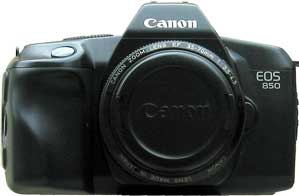
Lens Mount: EF (autofocus)
Film type: 35mm
Approx. dates of manufacture: 1988-1989
Battery: one 6V 2CR5 lithium
Approx. original price: $250
Approx. street value: Low
The original owner got the 850 with a Canon 50mm ƒ/1.8 EF lens, which used still sells for the same amount as the Canon 50mm ƒ/1.8 mark II does brand new. So the owner figured he could make more money if sold the lens and the body separately.
I paid $5 for the body. Didn't work out as well as he'd thought.
The 750 was another matter. I already had the 850 and had no interest in getting the 750 (see comment about model difference below); but one came up on an auction site paired with a 24mm EF lens that I wanted, so I bought the lens and got the body thrown in for free (or vice versa).
This was another of Canon USA's bizarre marketing scheme. It's like a political speech: at a glance it looks logical, but if you look at it closely it makes no sense.
So after the EOS 650 and 620 came out, Canon introduced another pair of bodies, the 750 and 850. The 750 was the base, and this 850 was the same thing but with a few features removed, which made it a little less expensive. Both of them were aimed at people who wanted point-n-shoot simplicity but with the better lenses, flashes, and overall quality. Or really to people who wanted an SLR but didn't want something complicated. So the 750/850 had a few different automatic exposure modes, but no full-manual, no overrides, no bracketing, and so on. They're also a little smaller and lighter than the 650, largely due to more plastic in the body in lieu of aluminum. The motor drive is also slower.
.jpg) They did offer an interesting new feature in the way the film advanced. On most cameras since the beginning of time, the film began on the supply spool and was wound slowly onto the take-up spool as exposures are made. On a 35mm camera, once all the exposures are made, the film is then rewound back into the cassette. On the 750 and 850, the camera would first wind all the film onto the takeup spool, and then after each exposure, it would rewind the film back into the cassette. The idea behind this is that if the camera back popped open accidentally, or the film jams or the camera dies or whatever, you'd only lose a couple of shots because the rest of the exposed film would be in the cassette and protected.
They did offer an interesting new feature in the way the film advanced. On most cameras since the beginning of time, the film began on the supply spool and was wound slowly onto the take-up spool as exposures are made. On a 35mm camera, once all the exposures are made, the film is then rewound back into the cassette. On the 750 and 850, the camera would first wind all the film onto the takeup spool, and then after each exposure, it would rewind the film back into the cassette. The idea behind this is that if the camera back popped open accidentally, or the film jams or the camera dies or whatever, you'd only lose a couple of shots because the rest of the exposed film would be in the cassette and protected.
The main difference between the 750 and 850 is that the 750 introduced the pop-up flash located in the pentaprism (a common feature these days); the 850 doesn't have it; if you want flash, you have to attach one onto the hot shoe.
For more information: Canon Camera Museum
Modern Photography magazine camera test (850): January 1989
Modern Photography magazine "SLR Notebook" preview (850): October 1988
One of Modern Photography magazine's Top Cameras
Camera manual: Orphan Cameras.com



